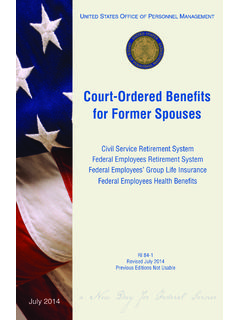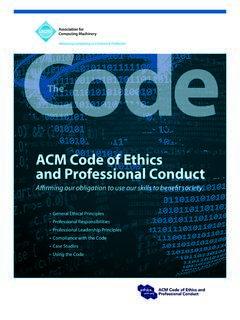Transcription of Fall Protection in Construction - Occupational Safety and ...
1 fall Protection in ConstructionOSHA 3146-05R 2015 This informational booklet is intended to provide an overview of frequently cited OSHA standards in the Construction industry. This publication does not alter or determine compliance responsibilities, which are set forth in OSHA standards and the Occupational Safety and Health and workers in the 27 states and territories that operate their own OSHA-approved workplace Safety and health plans should check with their state Safety and health agency. Their state may be enforcing standards and other procedures that, while at least as effective as Federal OSHA standards, are not always identical to the federal requirements. For more information on states with OSHA-approved state plans, please visit: contained in this publication is in the public domain and may be reproduced, fully or partially, without permission.
2 Source credit is requested but not information will be made available to sensory-impaired individuals upon request. Voice phone: (202) 693-1999; teletypewriter (TTY) number: photo: Dona FileOccupational Safety and Health Act of 1970 To assure safe and healthful working conditions for working men and women; by authorizing enforcement of the standards developed under the Act; by assisting and encouraging the States in their efforts to assure safe and healthful working conditions; by providing for research, information, education, and training in the field of Occupational Safety and fall Protection in Department of LaborOccupational Safety and Health AdministrationOSHA 3146-05R 2015 ContentsThe Continuing Need for fall Protection ..1 Why Does OSHA Have a Standard for fall Protection ? ..1 What Subpart M fall Protection Covers.
3 1 What is Subpart M? ..1 What are Employers Responsibilities to provide fall Protection ? ..2 When must employers provide fall Protection ? ..2 What Construction areas and activities does Subpart M cover? ..2 What kinds of fall Protection should employers use? ..3 Examples of fall Protection Requirements for Certain Construction Activities ..3 Leading Edges ..3 Overhand Bricklaying and Related Work ..4 Roofing Work on Low-Slope Roofs ..4 Working on Steep Roofs ..4 Residential Construction ..5 Other Walking or Working Surfaces ..5 Conventional fall Protection Systems ..6 Guardrail Systems ..6 Safety Net Systems ..8 Personal fall Arrest Systems ..10 Personal fall Arrest System Components ..11 Positioning Device Systems ..13 fall Restraint Systems ..13 Additional fall Protection Systems.
4 14 Warning Line Systems ..14 Controlled Access Zones ..16 Safety Monitoring Systems ..18 Other Hazards that Require fall Protection ..19 Hoist Areas ..19 Holes ..19 Ramps, Runways, and Other Walkways ..20 Excavations ..20 Dangerous Equipment ..20 Wall Openings ..20 Protection from Falling Objects ..21 Guardrails ..21 Overhand Bricklaying and Related Work ..21 Roofing Work ..21 Toeboards ..21 Canopies ..22 fall Protection Plans ..22 Presumption of Feasibility ..22 When Can I Use a fall Protection Plan? ..22 Elements of a fall Protection Plan ..23 fall Protection Training ..24 Requirements ..24 Verification of Training ..25 fall Protection Requirements in Other OSHA Construction Standards ..25 Subpart M fall Protection : Non-mandatory Appendices ..26 Definitions ..27 Workers Rights.
5 34 OSHA Assistance, Services and Programs ..34 NIOSH Health Hazard Evaluation Program ..37 OSHA Regional Offices ..37 How to Contact OSHA ..41 fall Protection IN CONSTRUCTION1 The Continuing Need for fall ProtectionWhy Does OSHA Have a Standard for fall Protection ?Historically, falls are the leading cause of fatalities in Construction , accounting for about one-third of all fatalities in the industry. For example, the Bureau of Labor Statistics reported that there were 291 fatal falls to a lower level in Construction in 2013, out of 828 total fatalities. OSHA recognizes that incidents involving falls are generally complex events, frequently involving a variety of factors. Consequently, the standard for fall Protection deals with both the human and equipment-related issues in protecting workers from fall hazards.
6 This publication is intended to help workers and employers better understand the fall Protection in Construction standard s requirements and the reasons behind them. What Subpart M fall Protection CoversWhat is Subpart M?Subpart M lays out the requirements and criteria for fall Protection in Construction workplaces. For example, it applies when workers are working at heights of 6 feet or more above a lower level. It also covers Protection from falling objects, falls from tripping over or falling through holes, and Protection when walking and working around dangerous equipment without regard to height. Subpart M provisions do not apply, however, to workers inspecting, investigating, or assessing workplace conditions prior to the actual start of work or after all Construction work has been completed.
7 The provisions of Subpart M can be found in Title 29 Code of Federal Regulations (CFR) Subpart M - fall Protection , 29 CFR , 29 CFR , 29 CFR , and 29 CFR Occupational Safety AND HEALTH ADMINISTRATION2 What are Employers Responsibilities to provide fall Protection ? Initially, employers must assess the workplace to determine if walking or working surfaces have the necessary strength and structural integrity to safely support the workers. Once it is determined that the work surfaces will safely support the work activity, the employer must determine whether fall Protection is required (using the requirements set forth in 29 CFR ) and, if so, select and provide workers with fall Protection systems that comply with the criteria found in 29 CFR When must employers provide fall Protection ? The 6-foot M requires the use of fall Protection when Construction workers are working at heights of 6 feet or greater above a lower level.
8 It applies at heights of less than 6 feet when working near dangerous equipment, for example, working over machinery with open drive belts, pulleys or gears or open vats of degreasing agents or Construction areas and activities does Subpart M cover?The standard identifies certain areas and activities where fall Protection or falling object Protection may be needed. For example, it might require fall Protection for a worker who is: on a ramp, runway, or another walkway; at the edge of an excavation; in a hoist area; on a steep roof; on, at, above, or near wall openings; on a walking or working surface with holes (including skylights) or unprotected sides or edges; above dangerous equipment; above a lower level where leading edges are under Construction ; on the face of formwork and reinforcing steel; or otherwise on a walking or working surface 6 feet or more above a lower level.
9 The standard may also require fall Protection where a worker is: constructing a leading edge; performing overhand bricklaying and related work; or engaged in roofing work on low-slope roofs, precast concrete fall Protection IN CONSTRUCTION3erection, or residential Construction . In addition, the standard requires falling object Protection when a worker is exposed to falling objects. What kinds of fall Protection should employers use? Generally, fall Protection can be provided through the use of guardrail systems, Safety net systems, or personal fall arrest systems. OSHA refers to these systems as conventional fall Protection . Other systems and methods of fall Protection may be used when performing certain activities. For example, when working on formwork, a positioning device system could be used. OSHA encourages employers to select systems that prevent falls of any kind, such as guardrails designed to keep workers from falling over the edge of a building.
10 Examples of fall Protection Requirements for Certain Construction Activities Leading Edges 29 CFR (b)(2)Each worker constructing a leading edge 6 feet or more above a lower level must be protected by guardrail systems, Safety net systems, or personal fall arrest systems. 29 CFR (b)(2)(i). Exception: When the employer can demonstrate that it is infeasible or creates a greater hazard to use these systems, the employer must develop and implement a fall Protection plan which meets the requirements of 29 CFR (k). See the section below on fall Protection Plans. Workers must be protected by guardrail systems, Safety net systems, or personal fall arrest systems, even if they are not engaged in leading edge work, if they are on a walking or working surface that is 6 feet or more above a level where leading edges are under Construction .
















